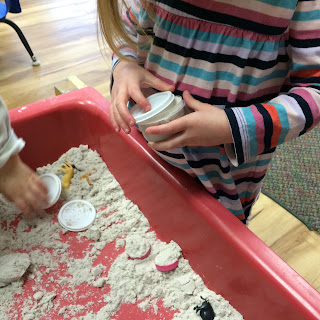One of my favorite materials to use with older
preschoolers are large glass beads (aka glass beads or sea glass). You can buy them in
bulk at dollar stores or craft stores, and the children use them in limitless
ways – as pretend food, for sorting, or for arranging into patterns and
designs.
Unfortunately they’re too small for toddlers and twos, or for any child who puts objects in their mouths. So I was thrilled to finally find glass beads and shapes that were bigger. Just to be sure, I checked them with a choke tube to make sure they were too wide to be choking hazards.
I put the beads out on a brightly colored metal tray, and some more in a bowl next to it, surrounded by a few different types of containers.
As the two-year-olds began to explore these new materials, their focus was mainly on transporting the beads from one container to another. A few of the children gave the containers a careful shake, and then a more energetic shake, noticing the difference in sound as the beads rattled against wood or against metal.
Soon other children came over to see what was going
on, and wanted beads of their own. One of the beauties of loose parts play is
that there’s usually a lot of the loose parts materials, which makes it easier
to share, even if you’re two-years-old. The child carrying the bulk of the beads in a wooden box carefully reached inside and pulled out two beads to
hand to each child. Two beads – one for each hand – seemed to be a satisfying
solution for everyone, and they sat, examining their beads.
As the morning went on, more beads were passed from
child to child, and more containers were filled. Soon, some of the beads were
transformed into “gold doubloons” that were hidden in “treasure boxes.” Some
were carried to the kitchen and transformed into food to put into the oven, and
water to pour into the sink.
And some beads stayed on the shelf, as children
transported them from one container to another, sometimes with their fingers,
sometimes by pouring from one container to another, watching as the physical
arrangement changed as the beads were lined up, stacked up, or simply put
into a pile in a bowl.
















